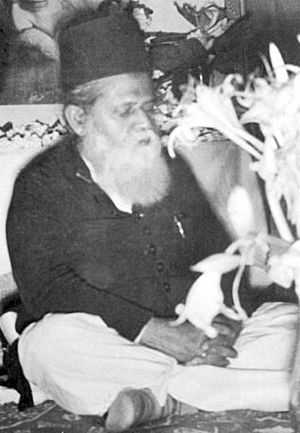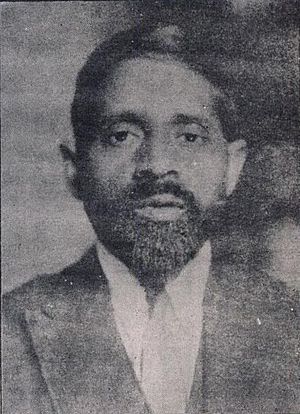Muhammad Shahidullah facts for kids
Quick facts for kids
Muhammad Shahidullah
|
|
|---|---|
| মুহম্মদ শহীদুল্লাহ | |

Shahidullah in a literary conference in Curzon Hall, Dhaka (April 1954)
|
|
| Born | 10 July 1885 |
| Died | 13 July 1969 (aged 84) |
| Education | Ph.D. |
| Alma mater |
|
| Occupation |
|
| Spouse(s) | Marguba Khatun |
| Children | 9, including Muhammad Takiullah and Murtaja Baseer |
| Awards | Independence Day Award (1980) |
| Honours | Chevalier de l'Ordre des Arts et des Lettres (1967) |
Muhammad Shahidullah (born July 10, 1885 – died July 13, 1969) was a very important Bengali scholar. He was a linguist, which means he studied languages. He was also a philologist, someone who studies old languages and texts. Besides that, he was an educator and a writer.
In 2004, the BBC held a poll to find the greatest Bengali people of all time. Muhammad Shahidullah was ranked number 16 on that list. This shows how much he was respected for his work.
Contents
Life and Education of Muhammad Shahidullah
Muhammad Shahidullah was born in a village called Peyara. This village is in the 24 Parganas area of West Bengal, which is now part of India. His family was very religious. His father, Mafizuddin Ahmed, worked as a warden at a shrine.
Shahidullah finished his school final exam in 1904. He then passed another important exam, the FA exam, in 1906 from Presidency College, Kolkata. In 1910, he earned his Bachelor of Arts degree with honors in Sanskrit from City College, Kolkata. He continued his studies and received his Master of Arts degree in 1912. This degree was in comparative philology from the University of Calcutta.
He later went to Sorbonne University in France. There, he earned his PhD degree in 1928. His research was about the different ways people spoke the Charyapada, which are ancient texts. He was the first Indian Muslim to get a doctorate degree from Sorbonne University.
Shahidullah's Career and Contributions
Muhammad Shahidullah started his teaching career in 1908. He taught at Jessore Zila School. In 1914, he worked as the headmaster of Sitakunda High School for a short time. After that, he practiced law in Bashirhat. In 1915, he was chosen as the Vice-Chairman of the town's local government.
He became a research fellow at the University of Calcutta from 1919 to 1921. In 1921, he joined the University of Dhaka as a lecturer. He taught both Sanskrit and Bangla languages. While at the University of Dhaka, he did important research. He studied how the Bengali language first began. In 1925, he shared his idea that Bangla came from an old language called Gaudi or Magadhi Prakrit.
From 1944 to 1948, he was the principal of Bogra Azizul Huq College. Then, he returned to the University of Dhaka. He became the head of the Bangla Department and the dean of the Faculty of Arts. He also taught French part-time in other departments. Later, from 1955 to 1958, he led the Bangla and Sanskrit Department at the University of Rajshahi. He also worked as an editor for the Islami Bishwakosh project.
Shahidullah's Language Skills
Muhammad Shahidullah was amazing at learning and speaking different languages. He was fluent in 24 languages. He also had a very good understanding of 18 other languages.
Some of the many languages he knew well include:
- Bengali
- Urdu
- Persian
- Arabic
- English
- Assamese
- Oriya
- Maithili
- Hindi
- Punjabi
- Gujarati
- Marathi
- Kashmiri
- Nepali
- Sinhala
- Tibetan
- Sindhi
- Sanskrit
- Pali
His ability to master so many languages was truly extraordinary.
Noteworthy Books by Muhammad Shahidullah
Muhammad Shahidullah wrote and translated many important books. Here are some of his well-known works:
- Sindabad Saodagarer Galpa (The Stories of the Merchant Sindbad, 1922)
- Bhasa O Sahitya (Language and Literature, essays, 1931)
- Bangala Byakaran (Bangla Grammar, 1936)
- Diwan-i-Hafiz (Poems of Hafiz, translation, 1938)
- Shikwah O Jawab-i-Shikwah (Questions and Their Answers, translation from Iqbal, 1942)
- Rubaiyat-i-Omar Khaiyam (Quatrains of Omar Khayyam, translation, 1942)
- Essays on Islam (1945)
- Amader Samasya (Our Problems, essays, 1949)
- Padmavati (Volume I ed, 1950)
- Bangla Sahityer Katha (History of Bangla Literature, Volume I in 1953, Volume II in 1965)
- Vidyapati Shatak (Collection of Vidyapati's Songs, text analysis, 1954)
- Bangla Adab Ki Tarikh (History of Bangla Literature, essays, in Urdu, 1957)
- Bangla Sahityer Itihas (History of Bangla Literature, 1957)
- Bangala Bhasar Itibrtta (History of Bangla Language, 1959)
- Amarkabya (Unforgettable Poetical Works, 1963)
- Sekaler Rupkatha (Fairy Tales of Ancient Time), 1965
Muhammad Shahidullah's Family
Muhammad Shahidullah had seven sons and two daughters. Their names are:
- Mohammad Raziullah
- Mohammad Safiyullah
- Mohammad Waliullah
- A K Mohammad Zakiyullah
- Mohammad Taqiullah
- Mohammad Naqiullah
- Mohammad Bashirullah
- Mohzuza Haque (born Khatun)
- Masrura Haque (born Khatun)
His son, A.K.M. Zakiyullah, started a school called 'Dr. Shahidullah Gyanpith'. He also created a research library. This library is named ’Dr. Shahidullah Memorial Library and Language Research Center’.
Another son, A.K.M. Bashirullah, is famous as Murtaja Baseer. He is known as one of the most talented painters in Bangladesh.
Awards and Honors for Muhammad Shahidullah

The University of Dhaka honored Muhammad Shahidullah in 1967. They made him a Professor Emeritus. This was for his lifelong work in language and literature research.
In the same year, the Government of France gave him a special award. It was called the Chevalier de l'Ordre des Arts et des Lettres. This award recognized his academic contributions to language and literature.
After he passed away, the Government of Bangladesh also honored him. In 1980, they gave him the Independence Award. This is one of the highest awards in Bangladesh.
Things Named After Muhammad Shahidullah
Many places and buildings have been named after Muhammad Shahidullah to honor him. These include:
- Dr. Muhammad Shahidullah Hall (a dormitory)
- Dr. Muhammad Shahidullah Academic Building at Rajshahi University


